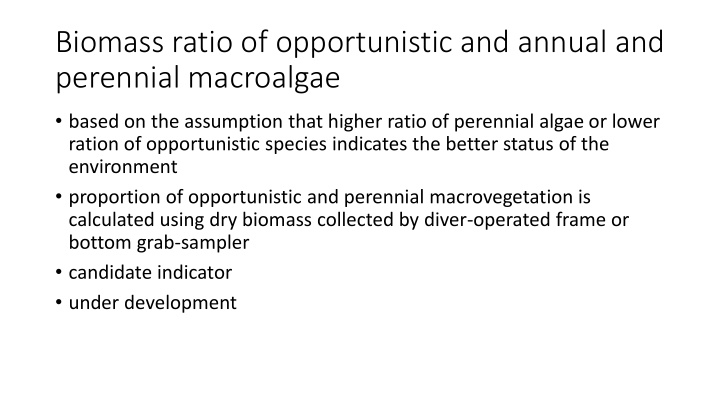



Biomass ratio of opportunistic and annual and perennial macroalgae • based on the assumption that higher ratio of perennial algae or lower ration of opportunistic species indicates the better status of the environment • proportion of opportunistic and perennial macrovegetation is calculated using dry biomass collected by diver-operated frame or bottom grab-sampler • candidate indicator • under development
Policy relevance of the pre-core indicator Primary importance Secondary importance BSAP Thriving and balanced communities of none stated Segment and plants and animals Objective Natural marine landscapes 5.3. Indirect effects of nutrient 1.6. Habitat condition (1.6.2. Relative MSFD enrichment (5.3.1.)Abundance of abundance and/or biomass, as appropriate) Descriptors and perennial seaweeds and seagrasses 1.7. Ecosystem structure (1.7.1. Criteria adversely impacted by decrease in water Composition and relative proportions of transparency ecosystem components (habitats and species)) Other relevant Ecological status indicator for WFD in legislation: one HELCOM countries (e.g. WFD)
GES-boundary concept • the reference value to be applied throughout the Baltic Sea due to the biogeographic and ecological differences between assessment units • WFD coastal types and water bodies are smallest assessment units • GES-boundary is proposed as 25% acceptable deviation from reference value
Applicability • applicable in all coastal areas • usable in soft, hard and mixed bottoms • in all cases specific reference conditions needed
Questions? • proportion of perennials or opportunistic species? • determination of annual/perennial or opportunistic species? • based on biomass or coverage data?
Existent biomass data • Estonia - ok • Latvia - ok • Poland- ok • Germany - ok • Sweden - partly • Finland ? • Russia ? • Denmark ?
Recommend
More recommend